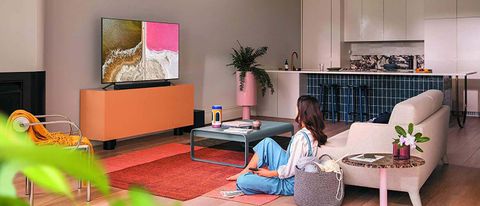Tom's Guide Verdict
The Samsung Q60T delivers sharp detail and bright colors — as long as you don’t push it too hard.
Pros
- +
Rich color and sharp details
- +
Alexa and Bixby inside; works with Google Assistant
- +
Lots of apps
Cons
- -
Blurring during fast action
- -
Limited viewing angle
- -
Dimming at edges of screen
Why you can trust Tom's Guide
Price: $999
Screen size: 65 inches
Resolution: 3,840 x 2,160
HDR: HDR10+, Hybrid Log-Gamma (HLG)
Refresh rate: 60Hz
Ports: 3 HDMI (1 with ARC), 2 USB
Audio: 2 channel, 20 watt (No Dolby Atmos)
Smart TV software: Samsung Smart TV (Tizen)
Size: 57.1 x 32.6 x 2.3 inches [w/o stand]
Weight: 49.2 pounds [w/o stand]
With its latest budget QLED set, Samsung giveth and taketh away, but the result is the same: The Samsung Q60T QLED TV is a good, but not great, 4K QLED TV. Samsung added Alexa inside — a nice upgrade over its Bixby voice assistant — and it lowered the price considerably (the 65-inch model now costs less than $1,000, versus $1,199 for last year’s Q60). In exchange for the lower price you lose one HDMI port — a fair trade off for most people. The Q60T also has a lower refresh rate than the previous model — which may be noticeable to some during game play and fast action sequences but isn’t a problem in most scenes.
Perhaps more significantly, the new Q60T is powered by Samsung’s Quantum Processor 4K Lite, a less powerful processor than was in last year’s model or in higher-end QLED sets this year. The overall result is a picture quality and viewing experience that doesn’t match the best LED units, such as those seen in our Vizio M-Series Quantum review or the TCL 6 Series Roku TV review.
Editor's Note: We have updated the pricing and availability section of this review to reflect current information. The rating and overall recommendations of our review remain unchanged from when it ran in July of 2020.
Samsung Q60T QLED TV review: Price and availability
We tested the 65-inch model of the Q60T, which costs less than $1,000 as of this writing at Best Buy, Amazon and other retailers, making it one of the best TVs under $1,000. But if 65 inches isn’t right for you, Samsung offers a full range of other sizes — from as small as 43 inches to as large as 85 inches — all with the same features and design.
43 inches QN43Q60TAFXZA - $529
50 inches QN50Q60TAFXZA - $788
55 inches QN55Q60TAFXZA - $899
58 inches QN58Q60TAFXZA - $999
65 inches QN65Q60TAFXZA - $999
75 inches QN75Q60TAFXZA - $1,299
85 inches QN85Q60TAFXZA - $2,499
Across these models, the Samsung Q60T QLED TV line is virtually identical, offering the same number of ports, the same 4K resolution and HDR support, and the same QLED display. All the sets use a dual backlight and feature the same processor. As a result, we expect the performance for all sizes to have the same strengths and weaknesses as the 65-inch model we used for this review.
Samsung Q60T QLED TV review: Design
The Q60T inherits the same simple, elegant design seen in last year’s Samsung Q60R QLED TV review. While not as thin as an OLED TV, the 57.1 x 32.6 x 2.3 unit still has a fairly narrow footprint. It has a slim bezel to make the most of the space it takes up. The dark plastic case feels sturdy and features a ribbon-like texture along the back for a little bit of flair; it’s not as elegant as metal cases you’ll find on higher end TVs, but it doesn’t look cheap.
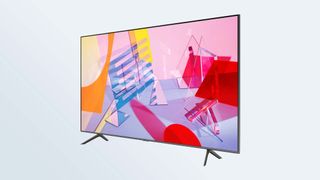
Samsung includes boomerang-shaped feet made of strong plastic that easily clip into the bottom of the TV and provide a solid base for resting it on top of a surface. With the stand, the unit takes up 11.4 inches at its widest. You can also use a wall mount (not included), either a standard 400 x 400-millimeter VESA mount or Samsung’s mini wall mount (convenient if you want to minimize how far the TV is separated from the wall).
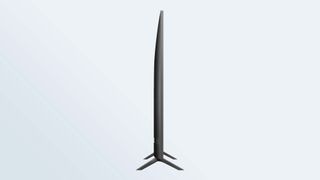
The Q60T screen uses a dual LED backlight that promises to improve contrast and color over its single LED predecessor. The dual backlight is composed of two sets of LEDs that offer different color temperatures. Higher-end Samsung QLED TVs employ a full array backlight. We saw the impact of the dual LED backlight in the unit’s brightness — it scored 414 nits, lower than the Q60’s 531 nits and well below the TCL 6 Series score of 608 nits.
Samsung Q60T QLED TV review: Ports
The Q60T has three HDMI ports — one less than last year's Q60 — including one that supports audio return channel (ARC) for one-cable connection and control of a soundbar. Will three be enough? Probably, especially with all the apps that are available through the TV’s Tizen OS, but make sure you won’t feel limited with the number of devices you can connect.

In addition to HDMI, the Q60T has a composite connection for older devices, two USB ports, an RF coaxial input for an antenna or cable and a digital optical audio output for connecting to a soundbar or receiver. It has an Ethernet port for a wired internet connection, and also supports 5GHz and 2.4Ghz Wi-fi. It offers Bluetooth for connecting to wireless headphones.

All the ports are on the back right of the TV, which makes them difficult to access without pulling the set away from the wall — another thing to consider if you find yourself frequently swapping out devices connected to your TV.
Samsung Q60T QLED TV review: Performance
The Q60T produces a sharp picture and good colors in most cases. While it has less processing power and a lower refresh rate than the older Q60, the impact to picture quality was only really evident in fast chase scenes, in which I saw some blurring. The TV supports HDR (high dynamic range) content, including Samsung's proprietary HDR10+ (but it doesn’t do Dolby Vision), which resulted in detailed colors on a variety of types of shows and movies. However, our testing showed its color gamut at 99.72 percent of the Rec 709 color space. That’s a bit lower than last year’s Q60 (99.96 percent) as well as the Vizio M-Series Quantum (99.96 percent) and TCL 6-Series Roku TV (99.92 percent), meaning the Q60T produces a few less colors than those models, but it’s not immediately noticeable.
Color accuracy was also off a bit, with a Delta-E score of 2.7; that’s compared to the Q60’s 1.6 and the TCL 6 Series 1.1 (lower scores are better). But it’s biggest problem is that as soon as you move too far from center, the colors quickly fade.

From a seat straight in front of the screen, I could see the details in the scenes of Blade Runner 2049 amid the deep dark of nighttime Los Angeles, while the neon lights of the future were bright and rich. Pods of dolphins diving in and out of the blue sea in Blue Planet II were distinct and detailed. But if I moved even 30 degrees from center, the colors changed and became less true — reds looked orange and deep blues became light blues. I also noticed dimming at the edges of the screen, likely a result of the set’s dual backlight instead of a full array backlight like the Hisense H8G and Vizio M-Series use.

When Chris Hemsworth fights a roomful of kidnappers in Extraction, the action was crisp and clean, but when he raced through the streets of Dhaka, the scenes weren’t as sharp. Similarly, the Q60T kept pace during most of the gameplay in Call of Duty, though when riding an ATV at full speed the wheels showed some blurring — perhaps due to the 60Hz refresh rate, which is down from 120Hz on the Q60, or because of the lower processing power. The unit switched to Game mode when I plugged in my Xbox One S. It clocked a fairly short lag time of 27.8 milliseconds with our Leo Bodnar input lag tester — better than the Vizio M-Series or TCL 6 Series, but significantly slower than the Q60’s 16.3 milliseconds.
The Q60T comes with four picture presets: Dynamic, Natural, Standard and Movie. I found Movie produced the most realistic flesh tones. All presets have motion smoothing enabled by default, which I turned off for testing. Motion smoothing gives the picture the “soap opera effect,” or can make the video action look very smooth or ultraprocessed; Samsung’s implementation made me feel nauseated.
Samsung Q60T QLED TV review: Audio
The two speakers inside the Q60T do a decent job of delivering sound, but it can’t match even the basic models from our list of the best soundbars.

It handles dialog best, making it easy to understand Zoe Kravitz and David H. Holmes debating the finer points of playlists during High Fidelity, and the speakers created a wide sound as the music played on the same show. But the lack of bass was very evident during action sequences like the lobby scene in the Matrix — the deep bass pushing the action was almost undetectable. The TV supports Dolby Audio, but not Dolby Atmos, though with the quality of the built-in speakers it probably doesn’t make much difference.
The Q60T’s 20-watts of power is half of the previous model’s but still enough to measure about 85 decibels at full volume — plenty for most rooms. When cranked up all the way, dialog became harder to understand, however.
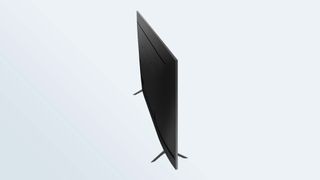
The TV offers three sound modes: Standard, Adaptive and Amplify. Adaptive adjusts the sound based on what you’re watching — movies or sports, for example — while Amplify boosts dialog. I found that Adaptive worked best for most viewing, balancing dialog and background music best of the available options.
Samsung Q60T QLED TV review: Smart features
The Q60T features the same Tizen smart TV platform as higher-end Samsung QLEDs and inherits all the benefits of the OS, including a huge selection of apps and support for multiple voice assistants.
The easiest way to set up the TV is to create a Samsung account online and install the Samsung SmartThings app on your phone. It detects the TV and walks you through set up. You can also use the onscreen menus for set up, but it’s much more laborious. With its SmartThings integration, you can also use your TV to control connected gadgets through your home.

The Tizen interface is very simple and easy to navigate for common tasks like launching frequently used apps. But it makes advanced settings a bit hard to find. For example, if you want to turn off motion smoothing, you have to go to Settings > Picture > Expert Settings > Picture Clarity Settings and then switch it off. But once you’ve got the settings the way you like them, you won’t often have to go hunting that deep in the menu system.
You won’t miss your Roku thanks to the large number of apps available through the OS. Beyond the expected — Netflix, Amazon Prime, Hulu, Disney+, YouTube — it has almost all the services we look for, including AT&T TV, Sling and YouTube TV for live streaming. HBO Max was available the day it launched. Some apps were sluggish to launch, likely because of the Q60T’s Lite processor, but once they were running I didn’t have problems with watching shows.
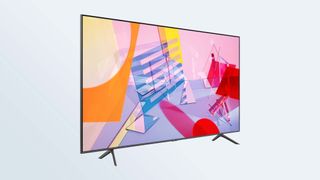
The biggest improvement Samsung introduced in the latest model is Amazon Alexa, which works without the need for an external Alexa smart speaker. You can still choose to use Bixby, Samsung’s voice assistant technology, but Alexa did a better job of understanding what I said and delivering relevant results. You can also connect your Google Assistant device to control the TV if that’s your preferred assistant.
Samsung Q60T QLED TV review: Remote control
The Q60T comes with the standard Samsung wand-style remote, which feels comfortable in your hand. Its minimalist design makes it easy to control basic functions, like volume and navigating onscreen menus. There are quick launch buttons for Netflix, Prime Video and Samsung TV Plus, its free live TV option (though there’s a question about whether you’ll want to launch the service enough to warrant a quick launch button). You can activate the voice assistant by holding the microphone button.
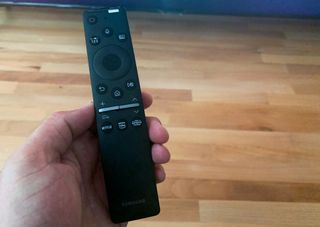
But the remote lacks buttons you often find on other TV remotes, such as for accessing settings and switching sound or video modes; you have to go to the Home screen and navigate to it yourself or use the voice assistant.
QLED TV review: Verdict
If you want a Samsung but can’t afford one of its premium models, the Samsung Q60T QLED TV will do the job as the most affordable model among the best Samsung TVs. It produces bright colors and sharp details in most circumstances. The addition of Amazon Alexa ups its virtual assistant game. But the changes from last year’s Q60 — less processing power and a lower refresh rate — affect performance for gaming and watching action scenes, and it still has issues with viewing angles.
For about the same amount of money, you can get better performing LED TVs, such as the the TCL 6-Series Roku TV (R635) or the Vizio M-Series Quantum, both which feature full array backlights and have better viewing angles.

Michael Gowan is a freelance technology journalist covering soundbars, TVs, and wireless speakers of all kinds of shapes and sizes for Tom’s Guide. He has written hundreds of product reviews, focusing on sound quality and value to help shoppers make informed buying decisions. Micheal has written about music and consumer technology for more than 25 years. His work has appeared in publications including CNN, Wired, Men’s Journal, PC World and Macworld. When Michael’s not reviewing speakers, he’s probably listening to one anyway.
-
Dondomingo Not sure I’m understanding unless there is difference between the refresh rate MHz as we know and the “motion rate” that Samsung has listed but on the device q60t I’m showing a 120 motion rate. Is this just a marketing gimmick?Reply -
Diceman0925 I wish I saw this review before I bought this TV. The picture loses a lot of clarity and color if you simply sit at one end of your couch. Also, with any action scene, there is a complete breakdown in the picture. The picture fragments and stutters. As I watched, I instantly thought that the TV's processor was not doing its job. Sure enough, I googled reviews and found this accurate depiction of the CONS vs PROS. Every CON is spot-on. For that alone, this TV should be ruled out as an option. My bad for failing to wait for the TCL 6 series to be restocked. Ugh.Reply
